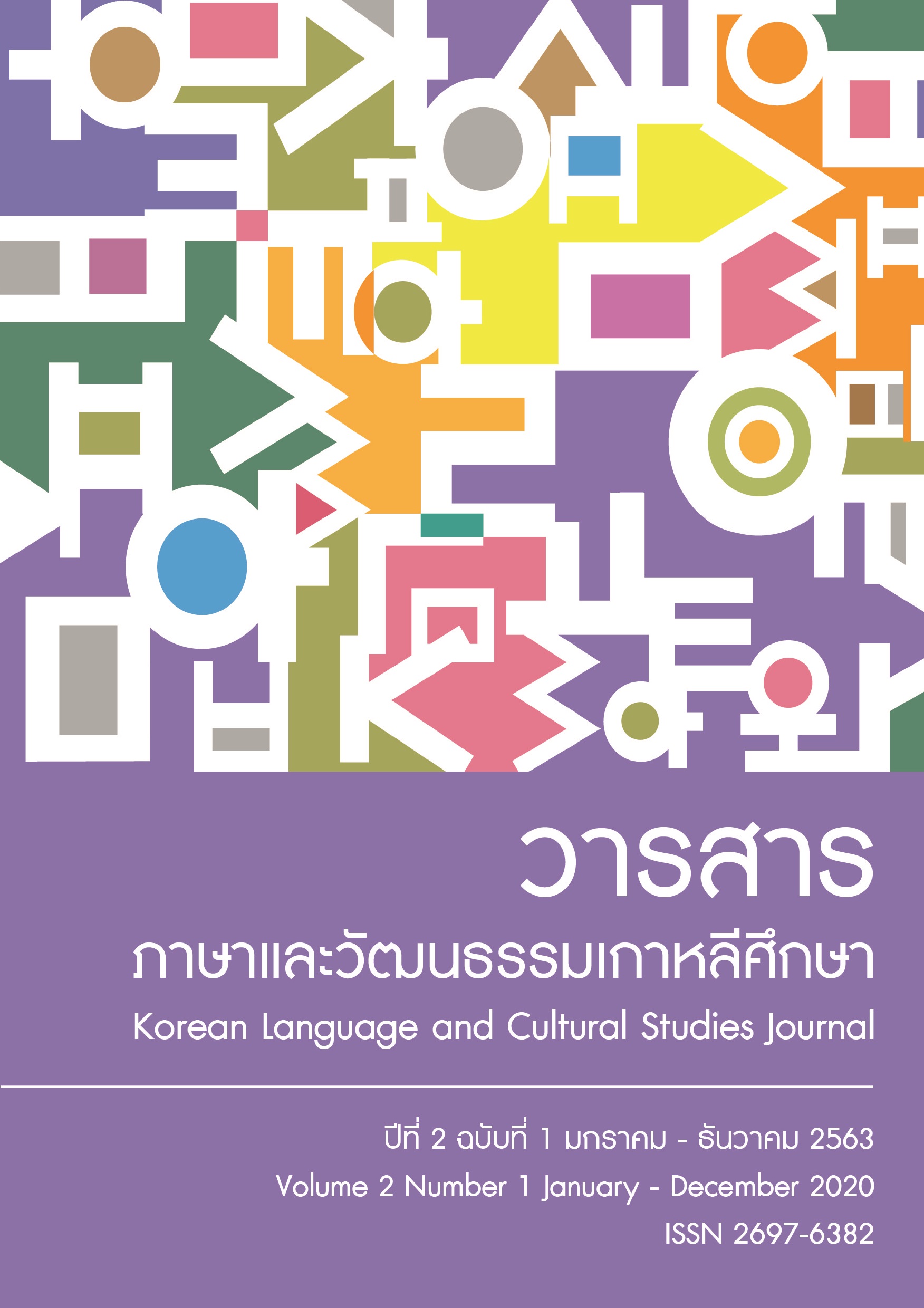คำศัพท์ร่วมในภาษาเกาหลีและภาษาไทยจากมุมมองเชิงประวัติเปรียบเทียบ
Main Article Content
บทคัดย่อ
งานวิจัยนี้ศึกษาคำศัพท์ร่วมในภาษาเกาหลีและภาษาไทยกว่าร้อยรายการโดยใช้กระบวนการทางภาษาศาสตร์เชิงประวัติเปรียบเทียบเพื่อวิพากษ์รากคำซึ่งสามารถจำแนกได้เป็นสามกลุ่ม ได้แก่ ๑. คำยืมจีน ๒. คำเลียนเสียงธรรมชาติ (คำสัทพจน์) และ ๓. คำศัพท์ที่ไม่ทราบที่มาแน่ชัด จุดสำคัญในการเปรียบเทียบคำยืมจีนร่วมอยู่ที่การแยกแยะอายุของรูปคำเนื่องจากคำยืมรูปก่อนภาษาจีนยุคกลางในภาษาไทยมักมีรูปที่ต่างออกไปจากคำศัพท์ร่วมในภาษาเกาหลี ในขณะเดียวกันคำยืมรูปภาษาจีนยุคกลางหรือหลังจากนั้นในภาษาไทยมักมีความคล้ายคลึงกับศัพท์ร่วมในภาษาเกาหลีอย่างเห็นได้ชัดเจนกว่า อีกจุดสำคัญอยู่ที่การเปรียบเทียบคำเลียนเสียงธรรมชาติข้ามตระกูลภาษา และการนำภาษาไทยและภาษาเครือญาติตระกูลไทกะไดมาบูรณาการกับการศึกษาศัพทมูลวิทยาภาษาเกาหลี ผลลัพธ์จากงานวิจัยนี้สามารถนำไปพัฒนาการเรียนการสอนภาษาเกาหลีให้แก่ผู้เรียนชาวไทยและการสอนภาษาไทยให้แก่ผู้เรียนชาวเกาหลีได้ด้วย
Article Details
References
우리말 큰사전 4, 옛말과 이두. (1992). 서울: 어문각.
Bailblé, Olivier. (2015). A History of the Korean Lexicon. International Journal of Teaching, Education and Language Learning, 2(3), 34-66.
Baxter, William. (1992). A Handbook of Old Chinese Phonology. Berlin: De Gruyter.
Baxter, William, & Sagart, Laurent. (2014). Baxter-Sagart Old Chinese reconstruction, Version 1.1 (20 September 2014). http://ocbaxtersagart. lsait.lsa.umich.edu/BaxterSagartOCbyMandarinMC2014-09-20.pdf.
Benedict, Paul K. (1989). Japanese-Austro/Tai. Ann Arbor: Karoma.
Bolnick, D. A. W., Shook, B. A. S., Campbell, L., & Goddard, I. (2004). Problematic use of Greenberg’s linguistic classification of the Americas in studies of Native American genetic variation. American journal of human genetics, 75(3), 519-523.
Burusphat, Somsonge, Suraratdecha, Sumittra & Yang Quan. (2000). Kam-Chinese-Thai-English dictionary. Bangkok: Mahidol University.
Burusphat, Somsonge, Wei Xuecun & Edmondson, Jerold A. (2003). Sui-Chinese-Thai-English Dictionary. Bangkok: Mahidol University.
Campbell, Lyle. (1996). On sound change and challenges to regularity. In M. Durie & M. Ross (Eds.), The comparative method reviewed: Regularity and irregularity in language change, pp. 72-89. Oxford University Press.
Campbell, Lyle. (1998). Historical Linguistics. An Introduction. Edinburgh University Press.
Chappell, Hilary. (2001). Synchrony and diachrony of Sinitic languages: A brief history of Chinese dialects. In H. Chappell (Ed.), Sinitic grammar: Synchronic and diachronic perspectives, pp. 3-28. Oxford University Press.
Choi Hakgŭn. (1978). = 최학근. 한국방언사전. 서울: 현문사.
Erickson, D. L., Smith, B. D., Clarke, A. C., Sandweiss, D. H., & Tuross, N. (2005). An Asian origin for a 10,000-year-old domesticated plant in the Americas. Proceedings of the National Academy of Sciences of the United States of America, 102(51), 18315-18320.
Ferlus, Michel. (2010). The Austroasiatic vocabulary for rice: its origin and expansion. Journal of the Southeast Asian Linguistics Society, 3, 61-76.
Fox, Anthony. (1995). Linguistic Reconstruction. An Introduction to Theory and Method. Oxford University Press.
Francis-Ratte, Alexander T. (2016). Proto-Korean-Japanese: A New Reconstruction of the Common Origin of the Japanese and Korean Languages (Doctoral dissertation). The Ohio State University.
Jung Hwan-Seung. (2012). = 정환승. 한국어와 태국어의 어희 비교 연구 – 중국어 영향을 중심으로. 동남아연구, 23(1), 151-185.
Jung Hwan-Seung. (2015). = 정환승. 한국어와 태국어 의성어에 관한 연구. 한국태국학회논총, 21(2), 91-133.
Khanitthanan, Wilaiwan. (2007). = วิไลวรรณ ขนิษฐานันท์. 2550. อิทธิพลภาษาอังกฤษ ภาษาเขมร และภาษาจีนในภาษาไทย มุมมองใหม่. ภาษาและภาษาศาสตร์, 26(1), 1-24.
Kim Minsu. (1997). = 김민수. 우리말 언어사전. 서울: 태학사.
King, J. Ross P. (1992). Archaisms and Innovations in Soviet Korean Dialects. Language Research, 28(2), 201-223.
Lee Ki-Moon, & Ramsey, S. Robert. (2011). A History of the Korean Language. Cambridge University Press.
Li Fang-Kuei. (1945). Some old Chinese loan words in the Tai languages. Harvard Journal of Asiatic Studies, 8, 333-342.
Li Fang-Kuei. (1976). Sino-Tai. Computational Analysis of Asian and African Languages, 3, 39-48.
Manomaivibool, Prapin. (1975). Study of Sino-Thai lexical correspondences (Doctoral dissertation). University of Washington, Seattle.
Manomaivibool, Prapin. (1976). Layers of Chinese loanwords in Thai. In T. W. Gething, J. G. Harris & P. Kullavanijaya (Eds.), Tai linguistics: in honor of Fang-Kuei Li, pp. 179-184. Bangkok: Chulalongkorn University Press.
Martin, Samuel E. (1997). How Did Korean Get -l for Middle Chinese Words Ending in -t? Journal of East Asian Linguistics, 6(3), 263-271.
Matisoff, James A. (1990). On megalo-comparison: a discussion note. Language, 66, 106-120.
Mitani, Yasuyuki. (1977). = 三谷 恭之. タイ・カダイ諸語の言語年代学的考察. 東南アジア研究, 15(3), 421-429.
Müller, A., Wichmann, S, Velupillai, V., Brown, C. H., List, M., Egorov, D., Belyaev, O., Mailhammer, R., Geyer, H., & Grant, A. (2010). ASJP World Language Tree of Lexical Similarity: Version 3 (July 2010).
Nam, Pung-hyen. (2009). = 남풍현. 고대 한국어 연구. 서울: 시간의 물레.
Nishida Tatsuo. (1975). Common Tai and Archaic Chinese. Studia Phonologica, 9, 2-12.
Ostapirat, Weera. (2000). Proto-Kra. Linguistics of the Tibeto-Burman Area, 23(1), 1-251.
Pittayaporn, Pittayawat. (2009). Phonology of Proto-Tai (Doctoral dissertation). Cornell University, Ithaca, New York.
Pittayaporn, Pittayawat. (2014). Layer of Chinese loanwords in Proto-Southwestern Tai as evidence for the dating of the spread of Southwestern Tai. Manusya, Special issue 20, 47-68.
Potibal, Puttachart. (2006). The comparative study of some Korean and Thai lexical items (Paper presented at the 3rd World Congress of Korean Studies, 27-30 October 2006, Jeju National University).
Prance, Sir Ghillean, & Nesbitt, Mark (Eds.). (2012). The cultural history of plants. London: Routledge.
Proschan, Frank. (2001). Peoples of the gourd: imagined ethnicities in highland Southeast Asia. The Journal of Asian Studies, 60(4), 999-1032.
Ramstedt, Gustaf John. (1949). Studies in Korean etymology. Helsinki: Société Finno-Ougrienne.
Räsänen, Martti. (1969). Versuch eines etymologischen Wörterbuchs der Türksprachen 1. Helsinki: Société Finno-Ougrienne.
Sohn Ho Min. (1999). The Korean Language. Cambridge University Press.
Vovin, Alexander. (2013a). Northeastern and Central Asia: “Altaic” linguistic history (Chapter 24). The Encyclopedia of Global Human Migration. Wiley Blackwell. https://doi.org/10.1002/9781444351071.wbeghm824.
Vovin, Alexander. (2013b). From Koguryŏ to T’amna: Slowly riding to the South with speakers of Proto-Korean. Korean Linguistics, 15(2), 222-240.
Vovin, Alexander. (2014). Why Koreanic is not Demonstrably Related to Tungusic? In S. H. To & K. Chung (Eds.), Korean within Altaic Languages and Altaic Languages within Korean, pp. 97-117. Seoul: ACSI, Gachon University.
Vovin, Alexander. (2015). On the Etymology of Middle Korean psʌr ‘rice’. In Türk Dilleri Araştırmaları (Festschrift für Uwe Bläsing), pp. 229-238.
Wade, Lizzie. (2014). Scientists solve mystery of World travelling plant. Science, February 2014.
Yu C’angdon. (1964). = 유창돈. 李朝語辭典 (이조어사전). 서울: 연세대학교출판부.
Yurayong, Chingduang, & Szeto, Pui Yiu. (2020). Altaicization and de-Altaicization of Japonic and Koreanic. International Journal of Eurasian Linguistics, 2(1), 108-148.

